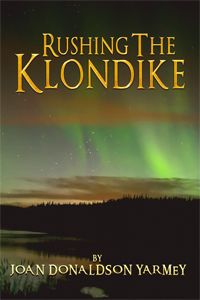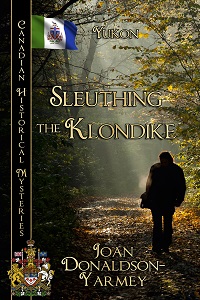
https://books2read.com/Romancing-the-Klondike

https://books2read.com/Rushing-the-Klondike

https://books2read.com/Sleuthing-the-Klondike
https://bwlpublishing.ca/donaldson-yarmey-joan/
I am a
proud Canadian author of over twenty fiction and non-fiction books in my long
writing career. But I am just one of thousands of published writers from this
huge country. Canada has had a long and illustrious history of producing world
renown authors and books going all the way back to the 18th century.
Frances
Moore was born in England in 1724. She was a well-known poet and playwright in
England before she and her husband, Reverend John Brooke moved to Quebec City
in 1763, for John to take up the post of army chaplain. During her time there
Frances wrote The History of Emily
Montague, a love story set in the newly formed Quebec province.
The
story is told through the voices of her characters by way of personal letters
between the two. This is known as epistolary (of letters) type of writing and
it was popular during the1700s in Europe. The Brookes’ returned to England in
1768 and the novel was published in 1769 the London bookseller, James Dodsley. The History of Emily Montague was the
first novel written in what is now Canada and the first with a Canadian
setting. Frances died in 1789.
Ontario
William
Robertson Davies was born August 28, 1913 in Thamesville, Ontario
(ON). He grew up surrounded by books and he participated in theatrical
productions, developing a lifelong love of drama. He attended Upper Canada
College then studied at Queen’s University at Kingston, ON. He moved to Oxford,
England where he received a Bachelor Degree in Literature from Balliol College
in 1938. His thesis, Shakespeare’s Boy
Actors, was published in 1939 and he began acting in London.
William married Brenda Mathews, an
Australian who was working as a stage manager. They moved to Canada in 1940 and
he began a career as literary editor at Saturday
Night magazine. Their first child was born in December 1940. Two years
later he accepted the position of editor of the Peterborough Examiner in Peterborough, ON. During this time he
wrote humorous essays under the name Samuel Marchbanks and wrote and produced
many stage plays.
In 1947, several of his essays were
published in The Diary of Samuel
Marchbanks, and The Table Talk of
Samuel Marchbanks came out in 1949. Davies used his early upbringing to
provide themes for his novels and his first novel Tempest Tost was published in 1951. His second, Leaven of Malice, came out in 1954. In
1955 he became publisher of the Peterborough
Examiner and his third novel, A
Mixture of Frailties was published in 1958.
Besides novel and play writing, and being
a newspaper publisher, Davies taught literature at Trinity College at the
University of Toronto from 1960 until 1981. He left his post as publisher of
the Peterborough Examiner in 1962 and became a Master of Massey College, the
University of Toronto’s new graduate college, in 1963. Along with his father
William Rupert Davies and his brother Arthur Davies, William bought the
Kingston Whig-Standard newspaper, CHEX-AM and CKWS-AM radio stations, and
CHEX-TV and CKWS-TV television stations. His third book of essays, Samuel Marchbanks’ Almanack was
published in 1967.
William Robertson Davies wrote a total of
eighteen fiction and non-fiction books, plus fifteen plays. He won many awards
for his writing including the Governor-General’s Literary Award and the Stephen
Leacock Award for Humour. He was named a Companion of the Order of Canada.
William Robertson Davies died on December
2, 1995, in Orangeville ON.
Josiah Henson was born on
June 15, 1789, into slavery in Port Tobacco, Charles County, Maryland. When his
family was separated by each being sold to different plantations, his mother
pleaded with her new owner, Isaac Riley, to buy her youngest son so she would
have him with her. Riley agreed and Josiah came to work for him. Josiah was
twenty-two years-of-age when he married. He also became a Methodist Minister
and was made the supervisor of his master's farm.
In 1825, Mr. Riley fell on hard times and was sued by a brother-in-law. Henson
guided eighteen of Riley’s slaves to Riley’s brother’s plantation in Kentucky.
When he returned and asked to buy his freedom from Riley for $450.00 (350.00
cash and $100.00 IOU), Riley added an extra zero to the IOU. Cheated of his
money, Henson returned to Kentucky. In 1830, he learned that he might be sold
again so he, his wife, and their four children escaped to Kent County, in Upper
Canada (now Ontario), which had been a refuge for slaves since 1793. That was
the year Lieutenant-Governor John Graves Simcoe passed: An Act to prevent the further introduction of Slaves, and limit the
Term of Contracts for Servitude within this Province. While the legislation
did not immediately end slavery, it did prevent the importation of slaves and
so any United States slave who entered the province was automatically free.
Josiah Henson worked on farms in Upper Canada before moving with friends
to Colchester to set up a Black settlement on rented land. He eventually was
able to buy 200 acres in Dawn Township and made the community self-sufficient.
The settlement reached a population of 500 at its height, earning money by exporting
black walnut lumber to the United States and Britain. Henson purchased an
adjoining 200 acres for his family to live on.
Henson served in the Canadian
Army as a military officer. He led a black militia unit in the Canadian
Rebellion of 1837-38. When slavery was abolished in the United States many
residents of the Dawn Settlement returned to their original home. Josiah Henson
and his wife had eight more children in Upper Canada and he remarried a widow
from Boston when his first wife died. He continued to live in Dawn for the rest
of his life and many of his descendants still live in the area.
Henson wrote his autobiography The
Life of Josiah Henson, Formerly a Slave, Now an Inhabitant of Canada, as
narrated by Himself. It was published in 1849 and many believe he inspired
the main character in Harriet Beecher Stowes’ Uncle Tom’s Cabin (1852). Henson then expanded his memoir and
published it as Truth Stranger Than
Fiction. Father Henson’s Story of His Own Life which came out in 1858. Since
people were still interested in his life, in 1876 his story was updated and
published as Uncle Tom’s Story of His
Life: An autobiography of the Rev. Josiah Henson.
Josiah Henson died on May 5, 1883 at the age of ninety-four.






























